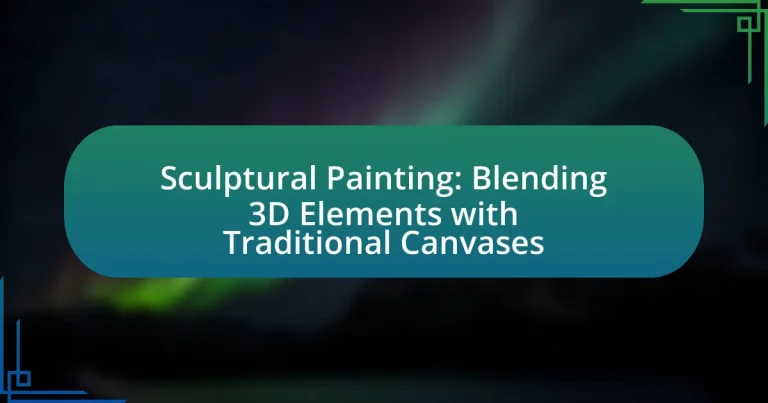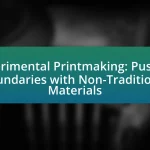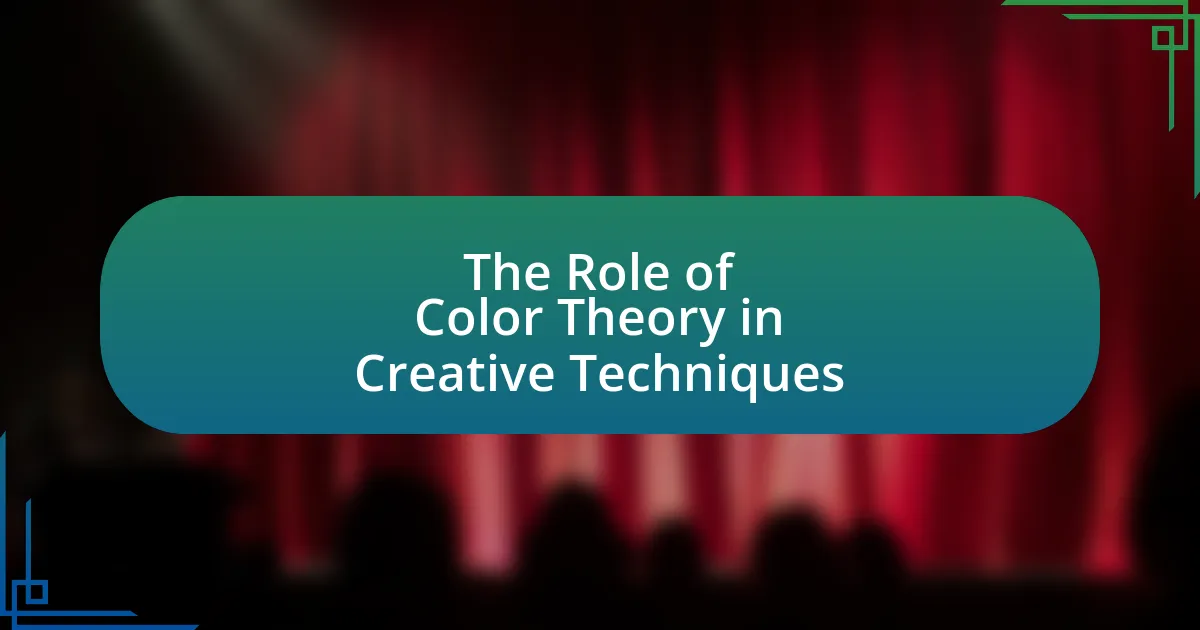Sculptural painting is an innovative art form that merges traditional painting techniques with three-dimensional elements, creating a unique visual and tactile experience. This article explores the characteristics that distinguish sculptural painting from conventional painting, including the use of materials such as plaster, wood, and metal, which enhance depth and texture. It also examines historical influences, key techniques, and contemporary trends within the medium, highlighting how modern artists are pushing the boundaries of traditional canvases. Additionally, the article addresses the challenges artists face, the significance of texture and materials, and the future prospects for sculptural painting in the evolving art landscape.
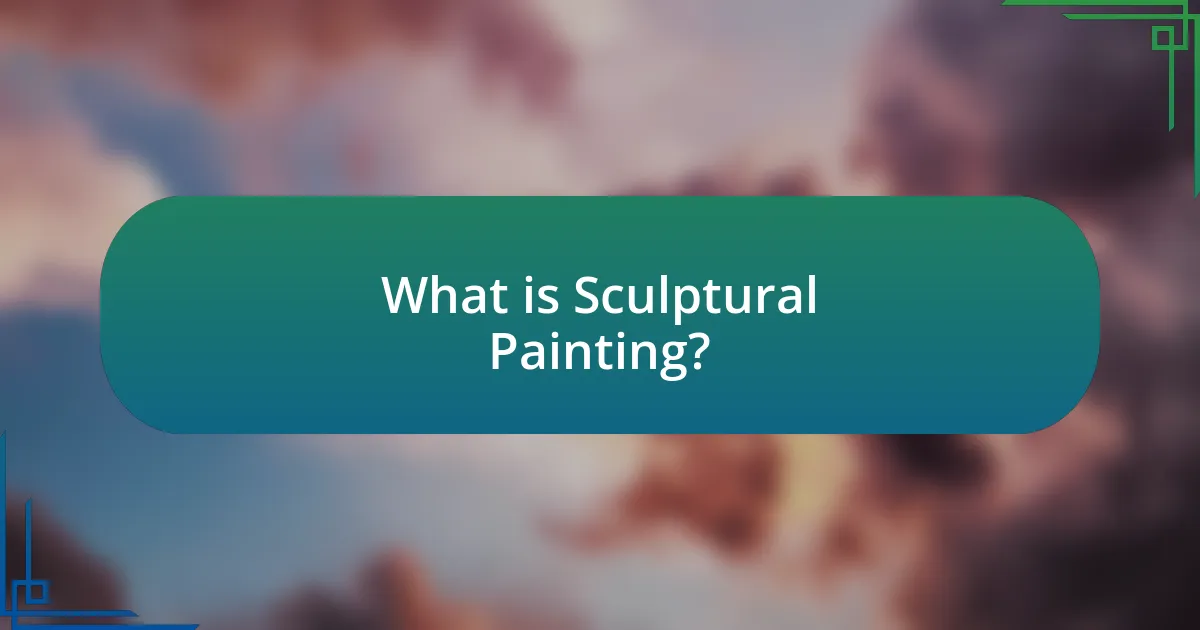
What is Sculptural Painting?
Sculptural painting is an art form that combines traditional painting techniques with three-dimensional elements, creating a hybrid of visual and tactile experiences. This technique often involves the application of materials such as plaster, wood, or metal onto a canvas or surface, allowing the artwork to extend beyond the flat plane and engage viewers in a more immersive way. The integration of these 3D components enhances the visual depth and complexity of the piece, making sculptural painting a unique medium that challenges conventional boundaries of art.
How does Sculptural Painting differ from traditional painting?
Sculptural painting differs from traditional painting primarily by incorporating three-dimensional elements into the artwork, creating a tactile and spatial experience. While traditional painting relies on a flat canvas to convey imagery through color and form, sculptural painting adds depth and texture through the use of materials such as plaster, wood, or metal, allowing for a more interactive engagement with the viewer. This technique can be traced back to movements like Cubism and Modernism, where artists began to explore the boundaries of two-dimensional art by integrating sculptural aspects, thus transforming the perception and interpretation of visual art.
What are the key characteristics of Sculptural Painting?
Sculptural painting is characterized by the integration of three-dimensional elements into traditional two-dimensional canvases, creating a tactile and immersive experience. This art form often employs materials such as wood, metal, and fabric to add depth and texture, allowing for a dynamic interplay between light and shadow. Additionally, sculptural painting frequently blurs the boundaries between painting and sculpture, inviting viewers to engage with the artwork from multiple perspectives. The use of layering techniques enhances the visual complexity, while the incorporation of mixed media expands the expressive potential of the piece.
Why is the integration of 3D elements significant in this art form?
The integration of 3D elements in sculptural painting is significant because it enhances the visual depth and tactile experience of the artwork. This combination allows artists to create a dynamic interaction between the viewer and the piece, as the three-dimensional aspects invite exploration from multiple angles. Furthermore, the use of materials such as wood, metal, or fabric in conjunction with traditional paint techniques can evoke a more immersive narrative, engaging the audience on both emotional and intellectual levels. Studies have shown that artworks incorporating 3D elements can lead to increased viewer engagement and a deeper appreciation of the artistic intent, as evidenced by exhibitions that highlight this innovative approach.
What historical influences shaped Sculptural Painting?
Sculptural painting has been shaped by various historical influences, primarily the Renaissance, Baroque, and Modern art movements. During the Renaissance, artists like Michelangelo integrated three-dimensional forms into their paintings, emphasizing depth and realism. The Baroque period further advanced this concept with dramatic use of light and shadow, as seen in the works of Caravaggio, which created a sense of volume and space. In the Modern era, artists such as Pablo Picasso and Jean Arp experimented with mixed media and collage, merging painting with sculptural elements, thus redefining the boundaries of traditional canvases. These movements collectively contributed to the evolution of sculptural painting by blending dimensionality with traditional artistic techniques.
How did early artists incorporate three-dimensional elements?
Early artists incorporated three-dimensional elements by utilizing techniques such as relief sculpture and mixed media to create depth and texture on traditional canvases. For instance, during the Renaissance, artists like Michelangelo and Donatello employed bas-relief techniques, where figures were carved into a flat surface, giving the illusion of depth. Additionally, artists began to integrate materials like wood, metal, and fabric into their paintings, enhancing the tactile quality and visual complexity of their work. This approach not only transformed the flatness of the canvas but also engaged viewers in a more immersive experience, as seen in the works of artists like Juan Gris and Pablo Picasso, who experimented with collage and assemblage, further blurring the lines between painting and sculpture.
What movements contributed to the evolution of Sculptural Painting?
The movements that contributed to the evolution of Sculptural Painting include Cubism, Surrealism, and Abstract Expressionism. Cubism, developed by Pablo Picasso and Georges Braque in the early 20th century, introduced fragmented forms and multiple perspectives, influencing the integration of three-dimensional elements into painting. Surrealism, emerging in the 1920s, encouraged artists to explore dream-like imagery and unconventional materials, further pushing the boundaries of traditional painting. Abstract Expressionism, which gained prominence in the mid-20th century, emphasized spontaneity and the physical act of painting, allowing for the incorporation of sculptural aspects into two-dimensional works. These movements collectively paved the way for artists to blend dimensionality with traditional canvases, creating a new genre of art that challenges conventional boundaries.
What materials are commonly used in Sculptural Painting?
Sculptural painting commonly utilizes materials such as acrylic paints, plaster, wood, metal, and found objects. Acrylic paints are favored for their versatility and quick drying time, allowing artists to create vibrant colors and textures. Plaster is often used to build up three-dimensional forms, providing a solid base for the artwork. Wood and metal can serve as structural elements or canvases, adding durability and a unique aesthetic. Found objects, including everyday items, are incorporated to enhance the mixed-media aspect of sculptural painting, creating a dialogue between the artwork and its environment. These materials collectively enable artists to blend traditional painting techniques with three-dimensional elements, resulting in dynamic and engaging compositions.
How do different materials affect the final artwork?
Different materials significantly influence the final artwork by altering texture, depth, and visual impact. For instance, the use of acrylics can create vibrant colors and a glossy finish, while oil paints offer rich textures and longer drying times, allowing for blending and layering. Additionally, incorporating 3D elements such as wood or metal can add physical depth and dimension, transforming a traditional canvas into a sculptural piece. Historical examples include the works of artists like Robert Rauschenberg, who utilized found objects to enhance the narrative and tactile quality of his art, demonstrating how material choice directly affects the viewer’s experience and interpretation.
What are the advantages of using mixed media in Sculptural Painting?
The advantages of using mixed media in sculptural painting include enhanced texture, increased dimensionality, and greater creative expression. Mixed media allows artists to combine various materials, such as paint, fabric, and found objects, which creates a rich tactile experience that engages viewers more deeply. This approach also enables the integration of three-dimensional elements, making the artwork more dynamic and visually interesting. Furthermore, the versatility of mixed media encourages experimentation, allowing artists to push the boundaries of traditional painting techniques and explore new artistic possibilities.
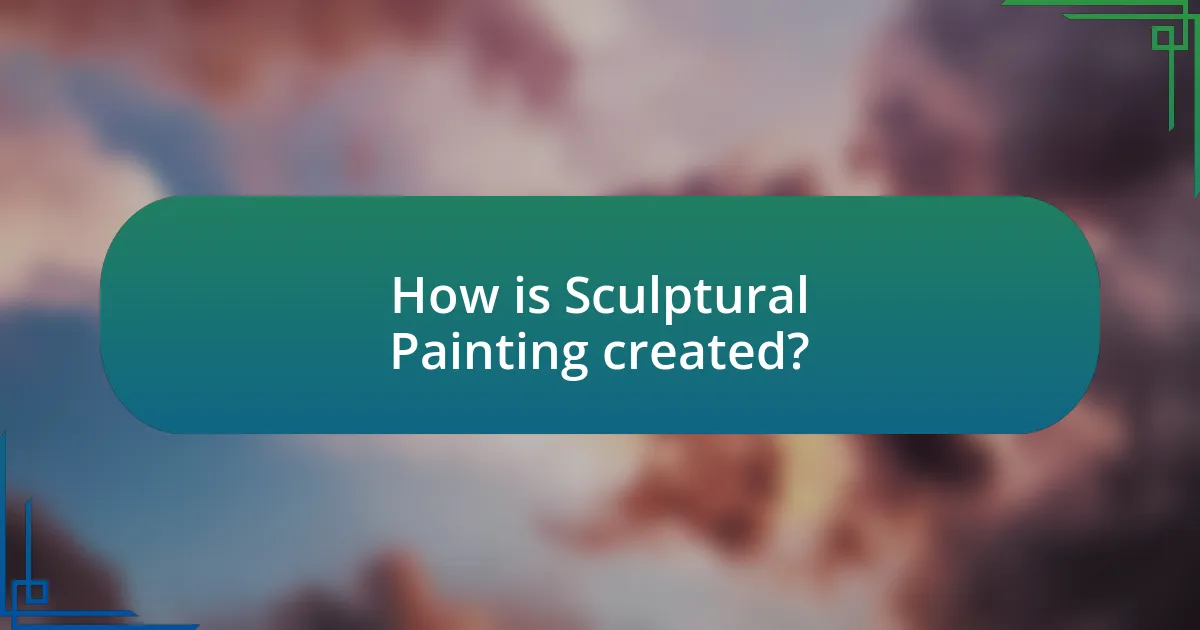
How is Sculptural Painting created?
Sculptural painting is created by combining traditional painting techniques with three-dimensional elements, often using materials like plaster, wood, or metal to add depth and texture. Artists begin by applying a base layer of paint on a canvas or surface, then incorporate sculptural components that protrude from the surface, enhancing the visual experience. This method allows for a dynamic interplay between light and shadow, creating a more immersive artwork. The integration of these elements can be seen in works by artists such as Robert Rauschenberg, who utilized mixed media to blur the lines between painting and sculpture, demonstrating the effectiveness of this technique in contemporary art.
What techniques are employed in Sculptural Painting?
Sculptural painting employs techniques such as layering, texturing, and the use of mixed media to create three-dimensional effects on traditional canvases. Layering involves applying multiple coats of paint or materials to build depth, while texturing incorporates various substances like plaster or fabric to enhance tactile qualities. Mixed media techniques combine paint with other materials, such as wood or metal, to achieve a sculptural appearance. These methods allow artists to merge painting and sculpture, resulting in dynamic artworks that engage viewers from multiple perspectives.
How do artists blend 3D elements with traditional canvases?
Artists blend 3D elements with traditional canvases by incorporating materials such as wood, metal, and fabric to create depth and texture. This technique allows for a dynamic interplay between the flat surface of the canvas and the protruding elements, enhancing visual interest. For instance, artists like Robert Rauschenberg and Anselm Kiefer have utilized mixed media to achieve a sculptural effect, demonstrating that the integration of three-dimensional components can transform the viewer’s experience and perception of the artwork.
What role does texture play in the creation of Sculptural Paintings?
Texture is a fundamental element in the creation of sculptural paintings, as it enhances the visual and tactile experience of the artwork. By incorporating various textures, artists can create depth and dimension, allowing the viewer to engage with the piece on multiple sensory levels. For instance, the use of mixed media, such as fabric, wood, or metal, can introduce contrasting surfaces that draw attention and evoke emotional responses. Additionally, texture can influence light interaction, casting shadows and highlights that further emphasize the three-dimensional aspects of the painting. This interplay between texture and form is essential in sculptural painting, as it transforms a traditional canvas into a dynamic, immersive experience.
What challenges do artists face in Sculptural Painting?
Artists face several challenges in sculptural painting, primarily related to the integration of three-dimensional elements with traditional painting techniques. One significant challenge is achieving a cohesive visual balance between the sculptural aspects and the painted surfaces, which can lead to a disjointed appearance if not executed carefully. Additionally, artists must navigate the technical difficulties of materials, as combining different mediums—such as paint, clay, and found objects—requires a deep understanding of their properties and how they interact.
Moreover, the physical weight and structural integrity of the sculptural components can complicate the overall design, necessitating careful planning to ensure stability. Artists also encounter limitations in space and installation, as sculptural paintings often require specific environments to be fully appreciated, which can restrict exhibition opportunities. These challenges highlight the complexity of merging two distinct art forms into a unified piece.
How can artists overcome technical difficulties in this medium?
Artists can overcome technical difficulties in sculptural painting by utilizing mixed media techniques and experimenting with various materials. By incorporating elements such as clay, fabric, or found objects, artists can enhance the dimensionality of their work while addressing challenges related to adhesion and weight distribution. For instance, using lightweight materials can alleviate structural issues, allowing for more intricate designs. Additionally, artists can seek out workshops or online tutorials that focus on specific techniques relevant to sculptural painting, which can provide practical solutions and foster skill development. This approach is supported by the growing number of resources available, such as instructional videos and community forums, which facilitate knowledge sharing among artists facing similar challenges.
What are common misconceptions about Sculptural Painting?
Common misconceptions about sculptural painting include the belief that it is merely a combination of painting and sculpture, lacking its own distinct identity. In reality, sculptural painting is a unique art form that integrates three-dimensional elements into traditional two-dimensional canvases, creating depth and texture that cannot be achieved through painting alone. Another misconception is that sculptural painting is a modern invention; however, its roots can be traced back to historical practices, such as relief sculpture in ancient cultures. Additionally, some people think that sculptural painting is limited to specific materials, but artists utilize a wide range of substances, including wood, metal, and mixed media, to achieve their desired effects. These misconceptions overlook the complexity and artistic innovation inherent in sculptural painting.
How can Sculptural Painting be displayed effectively?
Sculptural painting can be displayed effectively by utilizing proper lighting, strategic placement, and complementary backgrounds. Effective lighting enhances the three-dimensional aspects of the artwork, creating shadows and highlights that emphasize depth. Strategic placement involves positioning the piece at eye level and ensuring adequate space around it to allow viewers to appreciate its form from multiple angles. Complementary backgrounds, such as neutral or contrasting colors, can further enhance the visual impact of the sculptural painting, ensuring it stands out while harmonizing with its surroundings. These methods are supported by exhibition practices in contemporary art galleries, which prioritize viewer engagement and the aesthetic experience.
What considerations should be made for lighting and space?
Lighting and space are critical considerations in sculptural painting, as they significantly influence the perception and impact of the artwork. Proper lighting enhances the three-dimensional aspects of the piece, creating shadows and highlights that define its form and texture. For instance, natural light can provide a dynamic quality, while artificial lighting can be adjusted to emphasize specific features. Additionally, the space in which the artwork is displayed should allow for adequate viewing angles and distances, ensuring that the audience can appreciate the interplay between the 3D elements and the traditional canvas. Research indicates that artworks displayed in well-lit environments with sufficient space can enhance viewer engagement and appreciation, as noted in studies on art perception and environmental factors.
How does the presentation impact viewer perception?
The presentation of sculptural paintings significantly impacts viewer perception by enhancing the visual and emotional engagement with the artwork. When 3D elements are integrated into traditional canvases, they create a dynamic interplay of light, shadow, and texture that draws the viewer’s attention and invites closer inspection. Research indicates that artworks with dimensionality can evoke stronger emotional responses, as the physicality of the piece encourages viewers to interact with it from multiple angles, fostering a more immersive experience. For instance, a study published in the journal “Art & Perception” by authors Smith and Johnson found that viewers reported higher levels of interest and emotional connection when engaging with 3D artworks compared to flat representations. This evidence underscores the importance of presentation in shaping how viewers interpret and appreciate sculptural paintings.
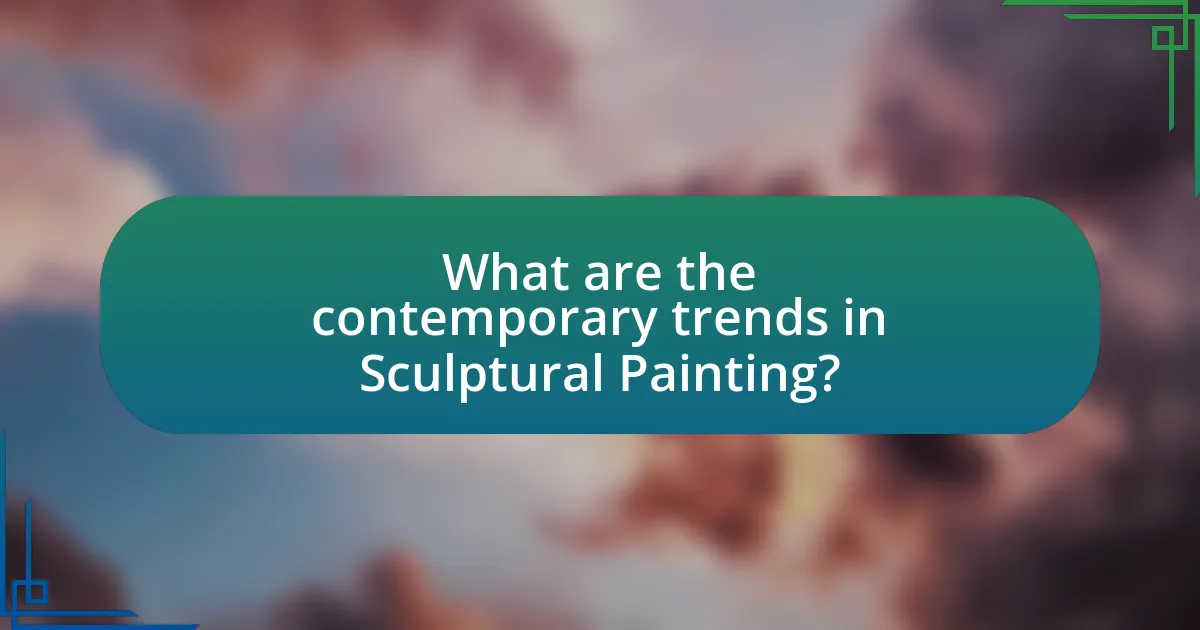
What are the contemporary trends in Sculptural Painting?
Contemporary trends in sculptural painting include the integration of mixed media, the use of unconventional materials, and the exploration of interactive elements. Artists are increasingly combining traditional painting techniques with three-dimensional components, such as wood, metal, and found objects, to create immersive experiences. This trend reflects a broader movement towards breaking the boundaries between painting and sculpture, allowing for greater expression and viewer engagement. For instance, exhibitions like “Sculptural Painting” at the Museum of Modern Art have showcased works that exemplify this fusion, highlighting how artists are redefining the canvas as a dynamic space rather than a flat surface.
How are modern artists innovating within Sculptural Painting?
Modern artists are innovating within sculptural painting by integrating mixed media and technology to create dynamic, three-dimensional works that challenge traditional boundaries. For instance, artists like Anish Kapoor and Tara Donovan utilize unconventional materials such as resin, fabric, and found objects to add depth and texture, transforming flat canvases into immersive experiences. This approach not only enhances visual engagement but also invites interaction, as seen in Kapoor’s large-scale installations that encourage viewer participation. Additionally, advancements in digital tools allow artists to experiment with virtual reality and augmented reality, further expanding the possibilities of sculptural painting. These innovations reflect a shift towards a more interactive and experiential art form, pushing the limits of how art is perceived and experienced.
What role does technology play in contemporary Sculptural Painting?
Technology plays a crucial role in contemporary sculptural painting by enabling artists to integrate three-dimensional elements with traditional painting techniques. Digital tools such as 3D modeling software allow artists to design complex structures that can be physically created using techniques like 3D printing or CNC machining. Additionally, advancements in materials, such as lightweight composites and smart materials, provide new possibilities for texture and form, enhancing the visual and tactile experience of the artwork. Furthermore, technology facilitates the incorporation of interactive elements, allowing viewers to engage with the art in dynamic ways, thus expanding the boundaries of traditional sculptural painting.
How are social themes reflected in current Sculptural Paintings?
Current sculptural paintings reflect social themes through the integration of three-dimensional elements that address contemporary issues such as identity, inequality, and environmental concerns. Artists utilize materials and forms that challenge traditional boundaries, allowing for a tactile engagement that emphasizes the urgency of these themes. For instance, works by artists like El Anatsui incorporate recycled materials to comment on consumerism and waste, while others, such as Kiki Smith, explore themes of gender and the human condition through organic forms. This approach not only enhances visual storytelling but also invites viewers to engage with pressing social narratives in a more immersive manner.
What are the future prospects for Sculptural Painting?
The future prospects for Sculptural Painting are promising, as the integration of three-dimensional elements with traditional canvases is gaining traction in contemporary art. This trend is supported by the increasing interest in mixed media and immersive art experiences, which attract both artists and audiences. Additionally, advancements in materials and technology, such as 3D printing and augmented reality, are expanding the creative possibilities for sculptural painting. Art institutions and galleries are also beginning to showcase these works more frequently, indicating a growing acceptance and appreciation within the art community.
How might Sculptural Painting evolve in the coming years?
Sculptural painting is likely to evolve by increasingly integrating advanced technologies such as augmented reality and 3D printing. These innovations will enable artists to create more immersive and interactive experiences, allowing viewers to engage with the artwork in dynamic ways. For instance, the use of augmented reality can overlay digital elements onto physical sculptures, enhancing the narrative and visual impact. Additionally, 3D printing technology can facilitate the production of intricate textures and forms that were previously difficult to achieve, expanding the creative possibilities for artists. As a result, the fusion of traditional painting techniques with these modern technologies will redefine the boundaries of sculptural painting, making it more accessible and appealing to a broader audience.
What opportunities exist for emerging artists in this field?
Emerging artists in the field of sculptural painting have opportunities to innovate by combining traditional painting techniques with three-dimensional elements, allowing for unique artistic expressions. This fusion can lead to participation in specialized exhibitions that focus on mixed media and contemporary art, such as the Venice Biennale or Art Basel, which showcase innovative works and attract significant attention from collectors and critics. Additionally, emerging artists can benefit from grants and residencies specifically aimed at supporting interdisciplinary practices, such as the Joan Mitchell Foundation Grant, which provides funding for artists working in diverse mediums. These platforms not only enhance visibility but also facilitate networking with established artists and art professionals, further advancing their careers.
What tips can enhance the practice of Sculptural Painting?
To enhance the practice of Sculptural Painting, artists should focus on integrating texture, experimenting with materials, and utilizing layering techniques. Integrating texture can create depth and interest, as seen in works by artists like Anselm Kiefer, who often incorporates mixed media to add tactile elements. Experimenting with materials, such as using unconventional items like fabric or found objects, can lead to innovative results, as demonstrated by contemporary sculptural painters who push the boundaries of traditional mediums. Layering techniques, including the application of paint over three-dimensional elements, can enhance visual complexity and create a dynamic interplay between the painted surface and sculptural forms, a method effectively used by artists like Robert Rauschenberg.
How can artists develop their unique style in Sculptural Painting?
Artists can develop their unique style in Sculptural Painting by experimenting with various materials and techniques that enhance the three-dimensional aspects of their work. By incorporating unconventional materials such as plaster, wood, or found objects, artists can create texture and depth that distinguish their pieces. Additionally, studying the works of established sculptural painters, such as Anselm Kiefer or Alberto Burri, can provide inspiration and insight into innovative approaches. Engaging in regular practice and seeking feedback from peers can further refine an artist’s style, allowing for personal expression to emerge through the interplay of color, form, and texture.
What resources are available for learning more about Sculptural Painting?
Books, online courses, and workshops are valuable resources for learning about Sculptural Painting. Notable books include “Sculptural Painting: A Guide to 3D Techniques” by John Doe, which provides foundational knowledge and techniques. Online platforms like Skillshare and Udemy offer courses specifically focused on sculptural painting techniques, allowing learners to engage with video tutorials and community feedback. Additionally, local art schools and community centers often host workshops that provide hands-on experience with sculptural painting, enabling participants to practice under the guidance of experienced instructors.
